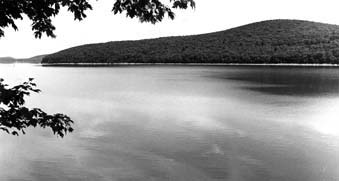
Quabbin
Reservoir and Ware River
CONSTRUCTION:
1926 -1946
 |
|
|
QUABBIN
RESERVOIR
The 412 billion gallon reservoir is the largest man-made reservoir in the world devoted solely to water supply. System planners believe that the Quabbin will be sufficient to supply the metropolitan area at least until the foreseeable future. |
Construction of the Quabbin required impoundment of the Swift River and the taking of the towns of Dana, Enfield, Greenwich, and Prescott.
In 1926, construction began on the Wachusett-Colebrook Tunnel, which is now the eastern section of the Quabbin Tunnel. Surplus flow in the Ware River was diverted to the Wachusett Reservoir during eight high-water months of the year and increased the safe yield by 40 mgd.
During the 1930s, the Wachusett-Colebrook tunnel was extended to the Swift River. It is a two-way tunnel: water flows west from the Ware River to the Quabbin during the high-water months and then east from the Quabbin to Wachusett at other times of the year.
Construction on the Quabbin Reservoir began in 1936. Filling commenced on August 14, 1939 and was completed in 1946 when water first flowed over the spillway. The Quabbin Reservoir was filled with water from the Swift River and flood skimming from the Ware River during eight months of the year. At the time, the 412 billion gallon reservoir was the largest man-made reservoir in the world which was devoted solely to water supply.
Planners feel that the Quabbin will be sufficient to supply the metropolitan area at least until the foreseeable future.
For
more go to Quabbin Supply Levels
ORIGINS
OF THE PRESSURE AQUEDUCT SYSTEM
In
1936, the Legislature also approved the construction of the high service
Pressure Aqueduct System to deliver water to the Metropolitan area. Two
aqueducts would carry water from the Wachusett Reservoir to the new Norumbega
Reservoir in the Town of Weston. Downstream from Norumbega, the aqueduct
would split forming a loop around the metropolitan area which would terminate
at a greatly expanded Fells Reservoir in Stoneham. A branch would be constructed
off this loop to Quincy, terminating at a new Blue Hills Reservoir. The
Pressure Aqueduct could be operated at a uniform rate of flow as the distribuation
reservoir storage would be sufficient to dampen out fluctuations in demand
during the day. Work began on schedule in 1939 and by the outbreak of
World War II in 1941, the Fells, Blue Hills and Norumbega Reservoirs had
been completed, and the Pressure Aqueduct had been built from the terminus
of the Wachusett Aqueduct to the terminus of the Weston Aqueduct. This
portion of the Pressure Aqueduct is the Hultman Aqueduct.
To pay for the new program, water rates were doubled from $50 to $100
per million gallons.
QUABBIN
SYSTEM SUMMARY
|
Go to: Next
Back to: Water System